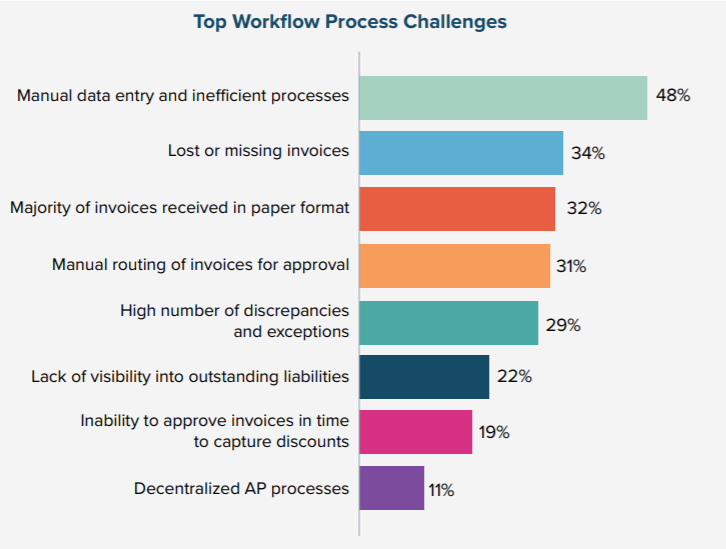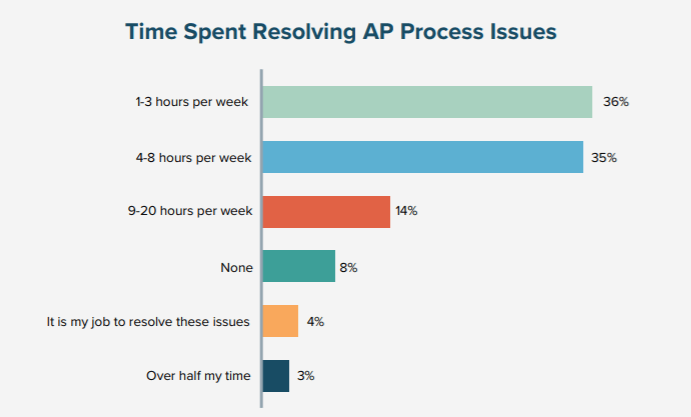Straight through processing may mean different things to different people in different contexts. But to most, straight through processing means eliminating all invoicing exceptions and the related labor for 100 percent of a company’s procurement activity, from the initial purchase order to the final payment.
Why should businesses aim for straight-through processing?
Various studies, including Levvel’s Payables Report, have shown that invoice exceptions are a major accounts payable workflow challenge for companies across many different industries.

By some estimates, around 30 percent of all invoices require some form of manual approval. When exceptions occur, the result is frequently late payments, long phone calls to and from suppliers and production delays.
In another report, Levvel reported that AP process issues, including exception handling, account for over 4 hours per week for 64% of respondents. This again highlights the importance of creating more effective accounts payable processes.

When considered over the course of a year, the average mid-sized company ends up losing tens of thousands of working hours to resolving invoice and purchase order discrepancies. With invoice exceptions leading to the likes of late payments, difficulties with suppliers and production delays, the resultant costs can end up stretching into the thousands of dollars per.

Yet, despite the grave threat that invoicing exceptions pose to the bottom line of the majority of companies in almost every industry, only around 45 percent of firms are actively seeking to rectify their procure-to-payment problems by moving towards a straight through processing model, as we have highlighted in a previous blog.
Many smaller companies have the misconception that straight through processing is a capital-intensive technique that only benefits large corporations who process large volumes of invoices. However, new software solutions, including accounts payable automation, have emerged within the last decade that put true straight through processing capabilities at the hands of even the smallest firms.
With modern tools and processes, true straight-through processing is a highly achievable goal
The ultimate goal of straight through processing may seem daunting as it entails nothing short of the complete elimination of human intervention in the procure-to-pay process. There have been a number of developments over the last decade that have made this goal not just a technical possibility but an eminently achievable one.
Optical Character Recognition (OCR) Software for Invoice Capturing
Invoice data capture can be an extremely monotonous, time-consuming, and prone to human error when conducted manually. Errors at this stage of the AP process will cause exceptions at the matching stage, in turn harming an organization’s chances of achieving straight through processing.
OCR software can scan invoices that arrive in the form of paper, electronic files, PDFs or emails and transfer the relevant data to a finance system, ready for matching. OCR uses a rule-based approach to scan all invoices for data, including:
– Invoice number
– Order and product/services details
– Payment terms
– Where to send payment
With data capture fully controlled by RPA, organizations save money that would have been spent on hiring outsourced teams. At the same time, AP staff that would have previously been responsible for data capture now get the opportunity to take on much more valuable knowledge customer-focused tasks that benefit both the organization and their career development and boosts morale significantly.
Robotic Process Automation (RPA) for Invoice Matching
Invoice matching is the primary challenge for AP teams in achieving straight through processing. With the help of RPA, however, invoice matching becomes a far more efficient process.
With RPA able to read an invoice at different levels, including both header and product, if an invoice contains all required data, it will be moved through the process automatically, without any need for human intervention. As a result, employees save a considerable amount of time.
Both optical character recognition and robotics process automation dramatically improve an organization’s opportunity for achieving straight through processing. The ultimate goal should not be to increase the efficiency with which mistakes are handled but to eliminate the mistakes from ever occurring in the first place.
Many organizations don’t realize that the most important steps towards eliminating the barriers to straight through processing do not involve the adoption of powerful software at all. On the contrary, there are steps that any business can take, reshaping their internal culture and processes in a way that enable software solutions likely to succeed.
Changing processes and culture
The biggest obstacle that most companies face in the implementation of straight through invoice processing is not technological but organizational. A few simple process and cultural changes can go a long way towards eliminating invoicing errors.
Metrics/KPIs
Carefully measuring metrics is an important step in that direction. As many as 60 percent of all companies simply don’t measure key performance indicators relating to invoicing. All companies should be, at a minimum, measuring straight through processing rates. Without careful tracking of key indicators, even diagnosing problems in the accounts payable process becomes impossible. We wrote a blog outlining the 7 AP metrics that actually matter to your CEO.
Understanding Invoice Error Reasons
Root-cause analyses are another critical step in understanding exactly why invoicing errors are occurring. Too many companies focus exclusively on rectifying invoicing exceptions after they occur. A far more effective means of combating these problems is to permanently eliminate them through better understanding the conditions that lead to these errors in the first place.
Accounts Payable and Procurement Alignment
Another important step to achieving straight through processing of invoices is to get all departments of the finance department, especially the purchasing and accounts payable departments, on the same page. This can be far easier said than done. It is important to explain clearly to all involved in a company’s procure-to-pay chain how substantial the time and resource savings can be once invoicing exceptions are eliminated.
Grafton Group plc
Grafton Group began their AP automation journey in 2013. Since then, they have experienced tremendous results ranging from improved supplier relationships to cost and time savings. Take a look at some of their specific results:
- 100% improvement in productivity.
- Grafton Group now automatically match 75% of all of their invoices. This means that the invoices will run straight through the AP process without any manual intervention.
- The invoice approval process, which was typically more than 40 days, now only takes 10 days.
Considering that this is a company with over 12,000 employees and over £2 Billion in revenue, you can really appreciate the significance of these improvements. Technology has affected almost every area of business and it is now time for AP to benefit and seize the opportunity. You can learn more about Grafton Group plc’s story here.
Conclusion
While most organizations realize the need to achieve true straight through processing of their invoices, many avoid addressing the issue due to the perceived complexities involved. However, by tackling the situation head-on with the adoption of an all-encompassing accounts payable solution, companies can drastically reduce the number of exceptions that occur. When coupled with a culture and process review, however, it is possible to eliminate invoice errors entirely.



